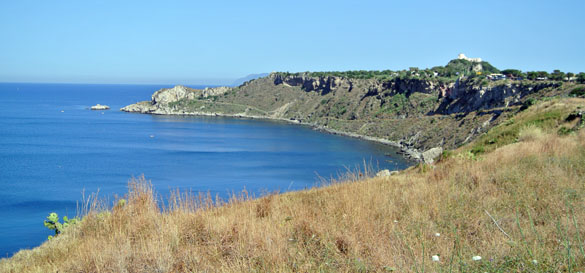 CATANIA, SICILY, ITALY–This was the last day of our International Bryozoology Association pre-conference field trip through Sicily. We had an excellent time and covered an extraordinary amount of territory on this large Mediterranean island. We started our final day on the Capo Milazzo Peninsula in the northeastern portion of Sicily. The view above is looking north from the base of the with the main lighthouse on the right and bay on the left. Just peeking around the headland in the distance is one of the Aeolian Islands. We climbed down to study the rocks in the middle distance.
CATANIA, SICILY, ITALY–This was the last day of our International Bryozoology Association pre-conference field trip through Sicily. We had an excellent time and covered an extraordinary amount of territory on this large Mediterranean island. We started our final day on the Capo Milazzo Peninsula in the northeastern portion of Sicily. The view above is looking north from the base of the with the main lighthouse on the right and bay on the left. Just peeking around the headland in the distance is one of the Aeolian Islands. We climbed down to study the rocks in the middle distance.
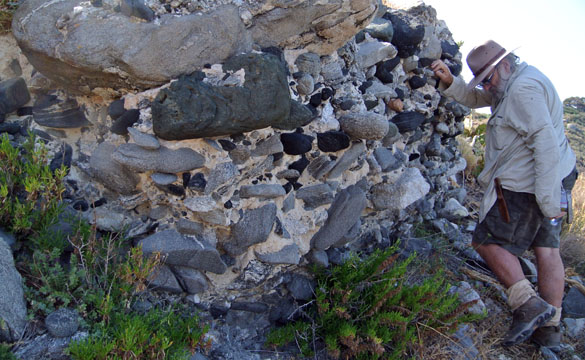 One of the most striking units we saw was this Pliocene conglomerate at the base of a small paleobasin cut into a Paleozoic metamorphic complex. The clasts are a variety of metamorphic rocks, from high-grade schists and gneisses to low-grade greenstones. Eckart Hakansson for scale.
One of the most striking units we saw was this Pliocene conglomerate at the base of a small paleobasin cut into a Paleozoic metamorphic complex. The clasts are a variety of metamorphic rocks, from high-grade schists and gneisses to low-grade greenstones. Eckart Hakansson for scale.
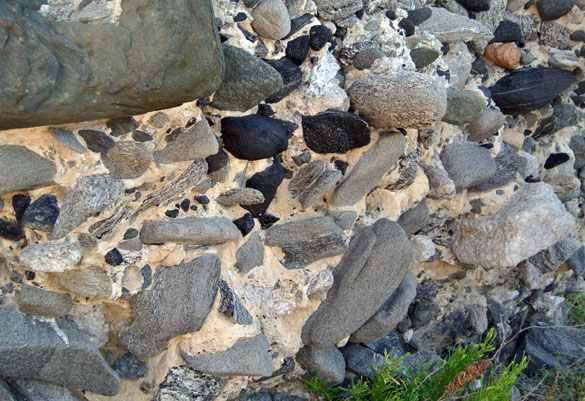 This is a closer view of the conglomerates. The matrix is a foraminiferan-rich marl almost identical to the marl which lies above it (see the next image).
This is a closer view of the conglomerates. The matrix is a foraminiferan-rich marl almost identical to the marl which lies above it (see the next image).
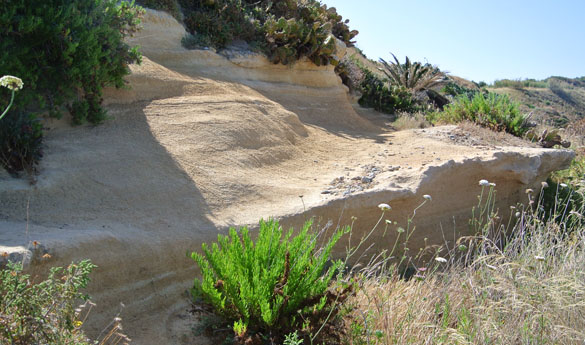 This Pleistocene (Gelasian) marl above the conglomerates is almost 95% planktonic foraminiferans, or at least it looks that way with a handlens. There are some other fossils (see below) and a few sand-sized lithic fragments, but otherwise this is a foraminiferan ooze deposit.
This Pleistocene (Gelasian) marl above the conglomerates is almost 95% planktonic foraminiferans, or at least it looks that way with a handlens. There are some other fossils (see below) and a few sand-sized lithic fragments, but otherwise this is a foraminiferan ooze deposit.
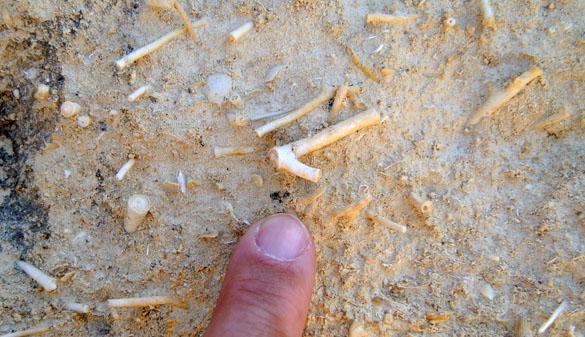 Besides the foraminiferans, the most common fossils in the Pliocene marls on the Capo Milazzo Peninsula are these stick-like objects. They are gorgonian octocoral internodes, probably from the species Keratoisis melitensis. I grabbed a handful and thereby tripled Wooster’s collection of fossil octocorals.
Besides the foraminiferans, the most common fossils in the Pliocene marls on the Capo Milazzo Peninsula are these stick-like objects. They are gorgonian octocoral internodes, probably from the species Keratoisis melitensis. I grabbed a handful and thereby tripled Wooster’s collection of fossil octocorals.
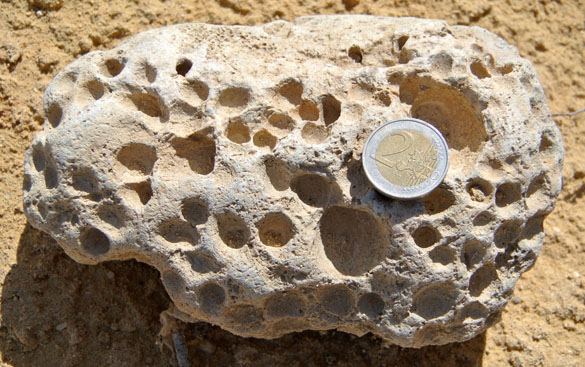 Included in the marls are these cobbles and boulders of Miocene limestones slumped in from the slopes above. They often have large borings from lithophagid bivalves (producing Gastrochaenolites) and a smaller background boring by clionaid sponges (making Entobia).
Included in the marls are these cobbles and boulders of Miocene limestones slumped in from the slopes above. They often have large borings from lithophagid bivalves (producing Gastrochaenolites) and a smaller background boring by clionaid sponges (making Entobia).
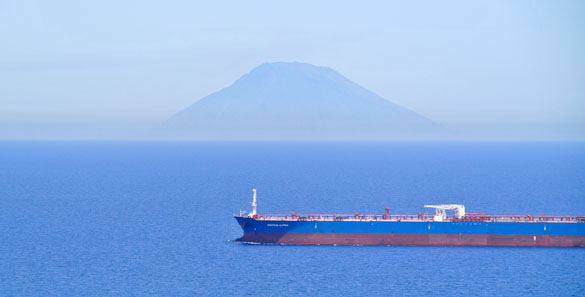 There are spectacular views from Capo Milazzo. This is looking north at the volcanic island of Stromboli. We spent a long time staring at it because every half-hour or so it spouts steam and smoke for a few seconds. I didn’t get to see an event, but there was a continual very light plume blowing from the right to the left.
There are spectacular views from Capo Milazzo. This is looking north at the volcanic island of Stromboli. We spent a long time staring at it because every half-hour or so it spouts steam and smoke for a few seconds. I didn’t get to see an event, but there was a continual very light plume blowing from the right to the left.
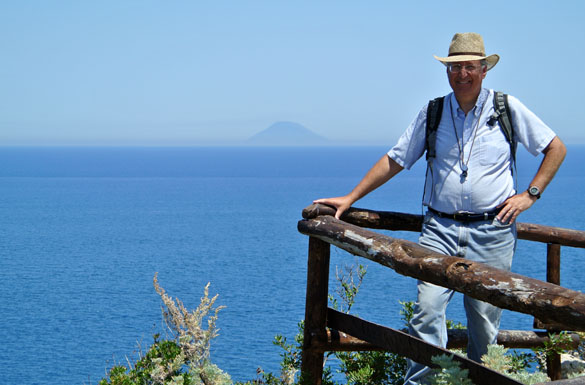 This is the only time I handed my camera to a colleague and asked for my picture taken. I couldn’t resist a view with Stromboli in the background. I also wanted to show off my new Italian hat. (I lost my regular and well-worn field hat somewhere along the way.)
This is the only time I handed my camera to a colleague and asked for my picture taken. I couldn’t resist a view with Stromboli in the background. I also wanted to show off my new Italian hat. (I lost my regular and well-worn field hat somewhere along the way.)
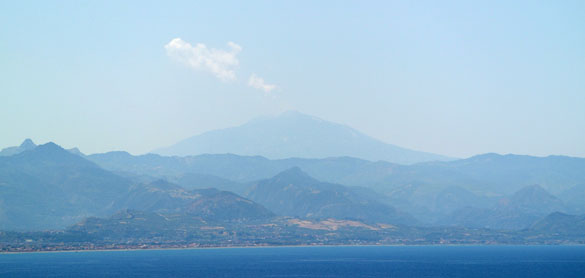 As we were leaving the peninsula, Mount Etna to the south let out a large puff of steam and gases into the murky air.
As we were leaving the peninsula, Mount Etna to the south let out a large puff of steam and gases into the murky air.
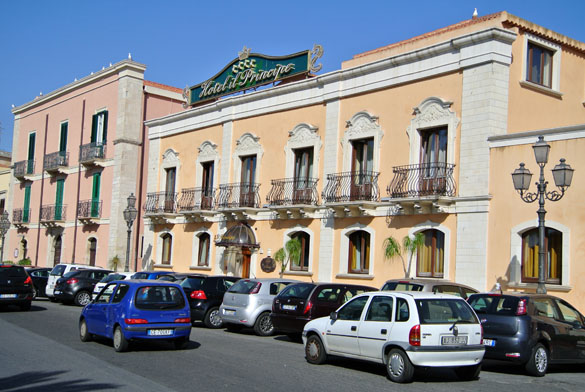 Finally, a few shots from today to show a bit how our field trip worked. Above is our hotel in Milazzo, typical of the places we stayed around Sicily. Note all the little Fiat cars. In every city and town these cars were constantly buzzing by.
Finally, a few shots from today to show a bit how our field trip worked. Above is our hotel in Milazzo, typical of the places we stayed around Sicily. Note all the little Fiat cars. In every city and town these cars were constantly buzzing by.
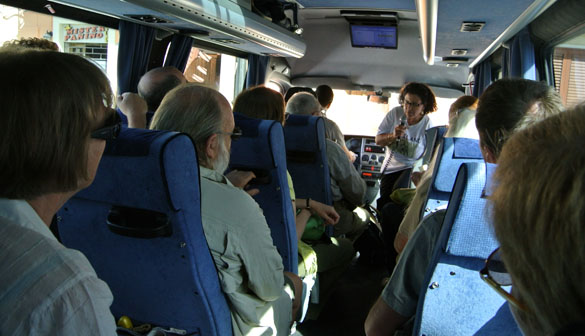 This is a view from my seat in our bus. Our intrepid leader Antonietta Rosso from the University of Catania is speaking in the microphone. We are very grateful to her for her planning, energy and good humor. My legs here, by the way, are extending well into the aisle because they just did not fit in these tiny Italian seats.
This is a view from my seat in our bus. Our intrepid leader Antonietta Rosso from the University of Catania is speaking in the microphone. We are very grateful to her for her planning, energy and good humor. My legs here, by the way, are extending well into the aisle because they just did not fit in these tiny Italian seats.
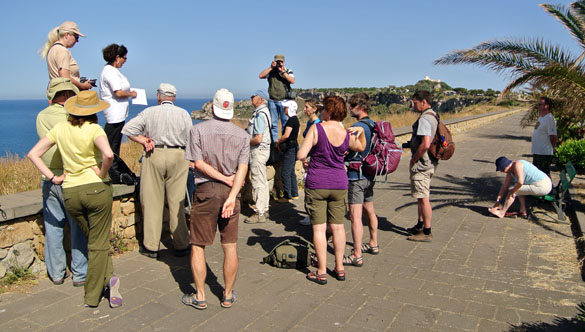 Antonietta Rosso is here giving us a field lecture before we descend down to the Capo Milazzo outcrops. The man taking photographs in the background is a keen Italian amateur who was very helpful. I wish I caught his name. He said one lifetime isn’t enough to enjoy all the wonders of this planet — and then there’s space!
Antonietta Rosso is here giving us a field lecture before we descend down to the Capo Milazzo outcrops. The man taking photographs in the background is a keen Italian amateur who was very helpful. I wish I caught his name. He said one lifetime isn’t enough to enjoy all the wonders of this planet — and then there’s space!
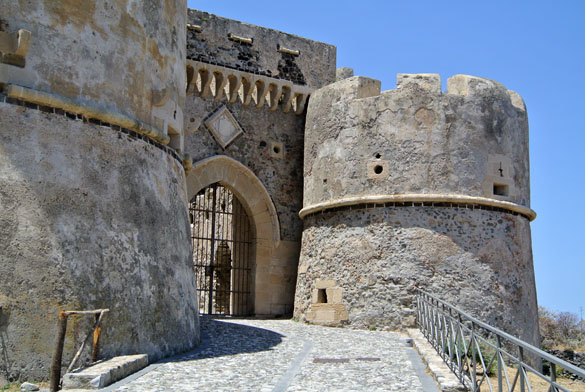 Just before lunch we had the requisite castle visit, this one in Milazzo. The Milazzo Castle suffered some bombing damage in World War II. The Germans and Italians used Milazzo and its port as a supply center for the Afrika Korps, and then later as a communications center for their resistance to the Allied invasion in 1943. The walls we are looking at here were built by the Spanish (Aragonese) in the 15th Century.
Just before lunch we had the requisite castle visit, this one in Milazzo. The Milazzo Castle suffered some bombing damage in World War II. The Germans and Italians used Milazzo and its port as a supply center for the Afrika Korps, and then later as a communications center for their resistance to the Allied invasion in 1943. The walls we are looking at here were built by the Spanish (Aragonese) in the 15th Century.
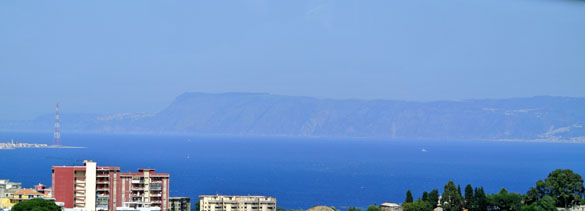 Finally we passed by the Strait of Messina, with mainland Italy visible through the haze. This narrow body of water is extraordinarily deep and its sides continue to be uplifted by tectonic activity. These waters have wicked currents and have been known as a navigational hazard since antiquity. When we saw this strait we knew we had rounded the corner of Sicily and nearly completed our journey around the entire island.
Finally we passed by the Strait of Messina, with mainland Italy visible through the haze. This narrow body of water is extraordinarily deep and its sides continue to be uplifted by tectonic activity. These waters have wicked currents and have been known as a navigational hazard since antiquity. When we saw this strait we knew we had rounded the corner of Sicily and nearly completed our journey around the entire island.
Thank you again to our University of Catania leaders, especially Antonietta Rosso and Rossana Sanfilippo. Now we have a few hours to rest before the official International Bryozoology Association Conference begins tomorrow morning.



Nice and interesting day with excursion at the Capo Milazzo a pleasure to meet people from different parts of the world interested in the ancient history of Sicily, you are always welcome in the land of Aeolus and Neptune
Wonderful pictures! Sorry to hear about your hat. Your new one looks great!
Thanks, Elyssa! It is much fun, though a long trip. Right now I’m in the meeting part of it, but at the end of the day we have another excursion. And the hotel retrieved my field hat! Hope you are well.
What a remarkable trip – I see how the history is inspired by the geology – I look forward to hearing more and borrowing your images when you return.